Don't miss our holiday offer - up to 50% OFF!
Discover the 3 Powerful Differences Between Black Wolfberry and Red Wolfberry for Vibrant Longevity!
Article Introduction
Is black wolfberry more “advanced” than red wolfberry?
The truth may overturn your cognition!
Research has found that red wolfberry is more effective in replenishing qi and blood than black wolfberry.
Unlock the Secret: 3 Key Differences Between Black Wolfberry and Red Wolfberry You Must Know!
Have you chosen the right wolfberry?
This article will help you to re-understand the core Differences Between Black Wolfberry and Red Wolfberry.
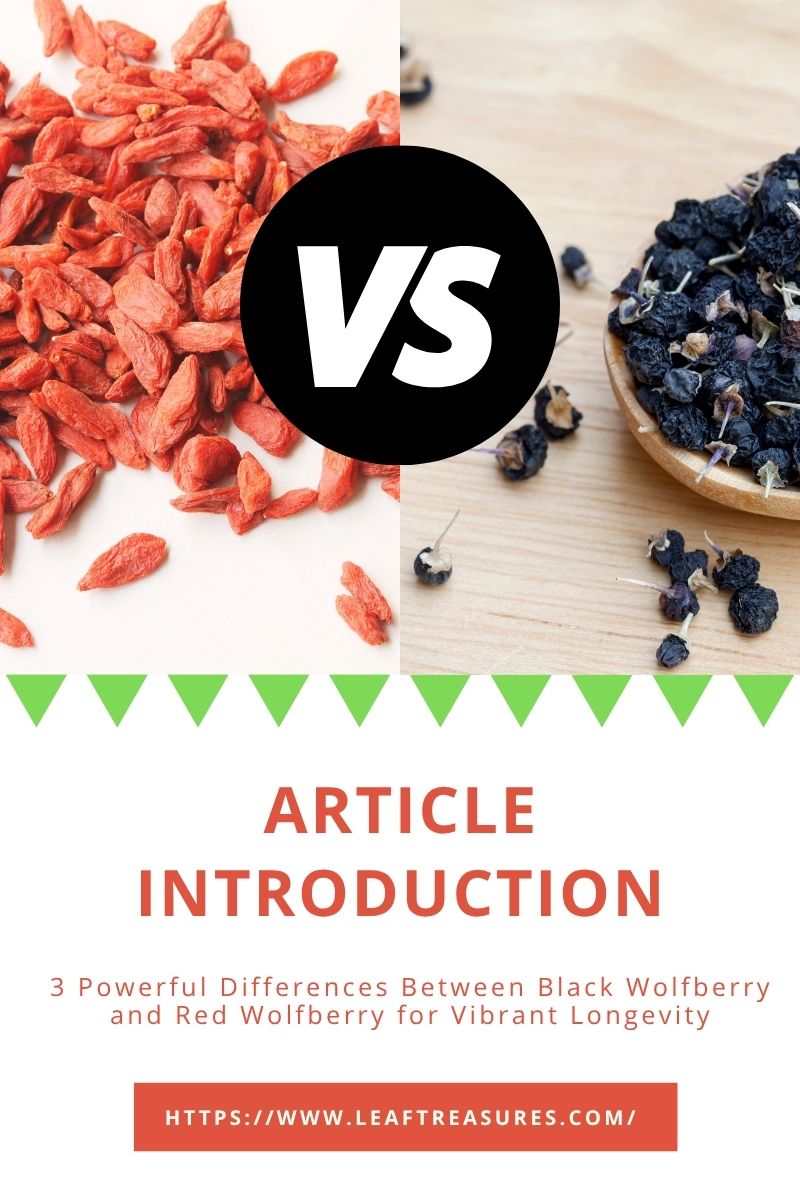
Difference Between Black Wolfberry and Red Wolfberry growing
First, let’s look at the Differences Between Black Wolfberry and Red Wolfberry growing.
starting from the most essential point to explore the most direct reasons.
Of course, this is also a question that many readers are concerned about, because this will directly affect our standards for the origin of the product when purchasing products.
Most people don’t know how different geographical environments will affect the products, which origin of the product to choose when purchasing products, and how they affect the quality of the product.
What is the Differences Between Black Wolfberry and Red Wolfberry growing?We will explain it in detail for everyone.
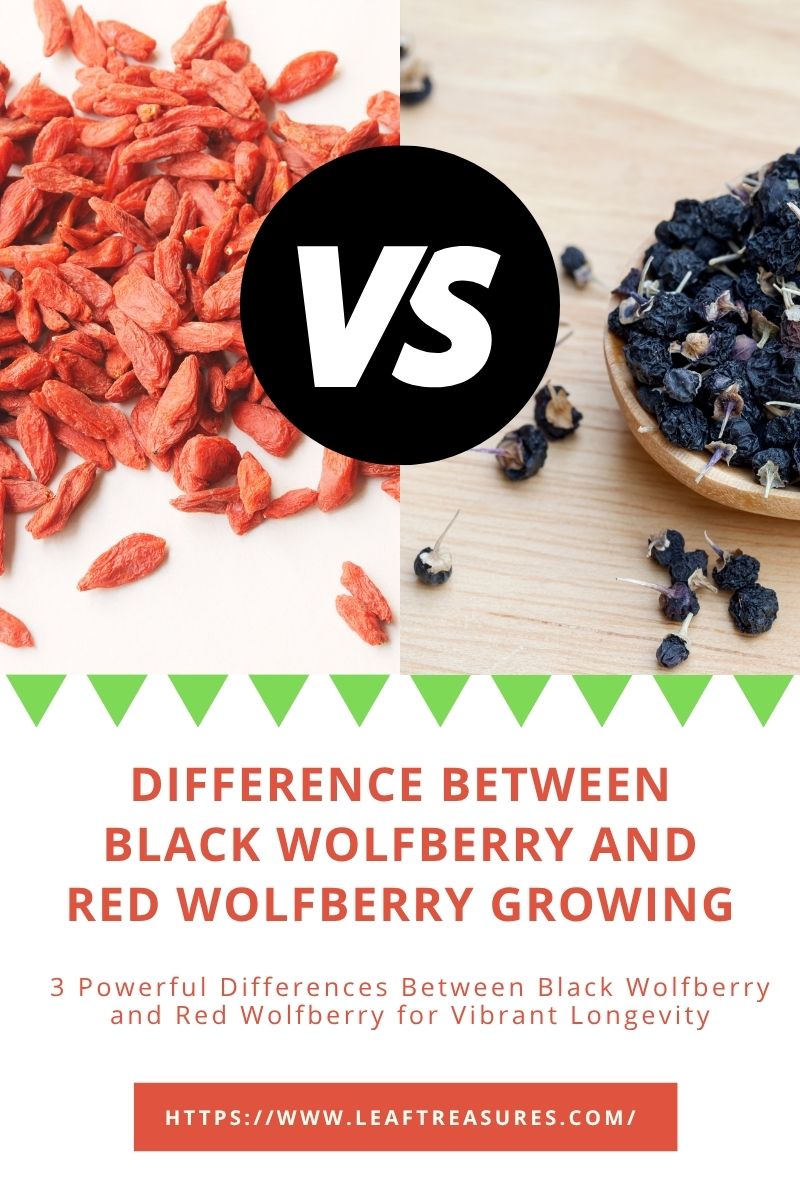
Geographical distribution and ecological adaptability of black wolfberry
Black wolfberry is mainly distributed in plateau areas with an altitude of 2000-3500 meters, such as the Qaidam Basin in Qinghai (2700-3000 meters) and the Ali region in Tibet (average 4500 meters)【1】.
It is distributed wild in the desert areas of Kazakhstan and Uzbekistan (such as the Kyzyl Kum Desert), but commercial cultivation is rare.
It is introduced and cultivated in the Caucasus region (Georgia, Azerbaijan) and the Mediterranean coast (such as Spain and Italy), but the humid climate leads to a low anthocyanin content (1.5%-2.0%).
Its growth environment is extreme, with annual precipitation of less than 200 mm and soil salt content as high as 3%-5%, but it can absorb water through deep roots (up to 3 meters underground), showing strong salt and drought resistance.
Differences Between Black Wolfberry and Red Wolfberry:
The ultraviolet radiation in high-altitude areas is strong, which stimulates black wolfberry to synthesize a large amount of anthocyanins to resist oxidative damage.
Its high salinity and strong light environment makes the anthocyanin content of black wolfberry reach 3.5%-4.2% (dried fruit), far exceeding that of other regions.

Geographical distribution and ecological adaptability of red wolfberry
Differences Between Black Wolfberry and Red Wolfberry,Red wolfberry is a typical mid-temperate arid climate zone adaptor. Its growth requires an average daily light of more than 8 hours.
For example, the annual average sunshine in Zhongning, Ningxia, China exceeds 3,000 hours, and the temperature difference between day and night reaches 10-16℃, which promotes the accumulation of sugar and nutrients in the fruit.
Zhongning County and Helan County, the world’s recognized high-quality red wolfberry production base, account for more than 40% of China’s production【2】.
In addition to China, there are a small number of wild distributions in Central Asian countries such as Kazakhstan and Uzbekistan, but commercial cultivation is very rare.
European Mediterranean coastal countries (such as Spain and Italy) introduced cultivation, but the humid climate caused the fruit quality (such as polysaccharide content) to be lower than that of Chinese production areas.
There are experimental plantings in southern North America (such as California, USA), but it has not yet formed a large-scale industry.
The introduction was successful in some areas of South Africa, but the output is limited and mainly supplied to the local market.
Differences Between Black Wolfberry and Red Wolfberry:
Because when the temperature difference between day and night is large, photosynthesis is strong during the day and respiration is weak at night, and more sugar and nutrients accumulate.
Light response: Medium to strong light activates the expression of PAL (phenylalanine ammonia lyase) gene, promoting the synthesis of carotenoids (such as β-carotene and zeaxanthin).

Summary of Differences Between Black Wolfberry and Red Wolfberry growing
Black wolfberry is mainly distributed in the arid areas of northwest China, such as the Qaidam Basin in Qinghai, the surrounding areas of the Taklimakan Desert in Xinjiang, and the Hexi Corridor in Gansu.
Its growth environment is extreme, with annual precipitation less than 200 mm and soil salt content as high as 3%-5%, but it can absorb water through deep roots (up to 3 meters underground), showing strong salt and drought resistance.
In contrast, red wolfberry (Lycium barbarum) has a wider adaptability and is planted from the eastern foot of the Helan Mountains in Ningxia to the Bashang grassland in Hebei, but Ningxia Zhongning is the core production area.
The average annual precipitation in this area is about 400 mm, the soil pH is 7.5-8.5, the light is sufficient and the temperature difference between day and night is large, which is conducive to sugar accumulation.
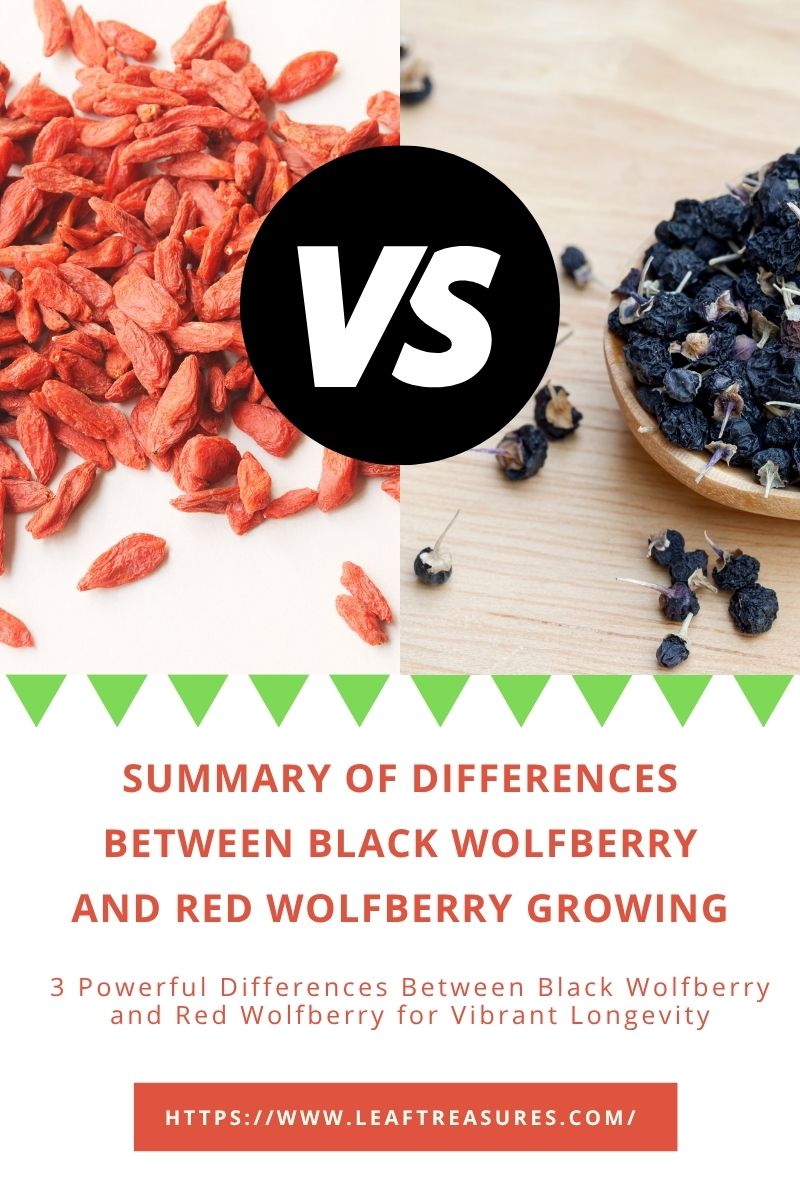
difference between black wolfberry and red wolfberry nutrition
If you only know that red wolfberry and black wolfberry have different colors or only know that their growing environments are different.
Do you really know whether they are suitable for you?
According to a survey, 68.7% of people do not know what the nutritional differences are between them, so they do not know how to buy them.
Don’t worry, next we will introduce the differences between black wolfberry and red wolfberry from the nutritional differences between them.

difference between black wolfberry and red wolfberry nutrition:anthocyanin content
The core advantage of black wolfberry lies in its anthocyanin content【3】.
According to high-performance liquid chromatography (HPLC), the anthocyanin content in every 100 grams of dried fruit is 3690 mg, which is 2.2 times that of blueberries and 1.8 times that of black currants.
Its main components are delphinidin-3-O-glucoside and cyanidin-3-O-glucoside, which account for more than 70%.
Differences Between Black Wolfberry and Red Wolfberry:
Red wolfberry contains almost no anthocyanin, and its antioxidant capacity mainly depends on vitamin C (48 mg per 100 grams) and carotenoids (8.5 mg of β-carotene per 100 grams).

difference between black wolfberry and red wolfberry nutrition:Polysaccharide and amino acid composition
The polysaccharide content of red wolfberry (5.8 grams per 100 grams of dried fruit) is significantly higher than that of black wolfberry (3.2 grams), and its polysaccharide molecular weight is smaller (average 12 kDa vs. 18 kDa), which is easier to be absorbed by the human body【4】.
Differences Between Black Wolfberry and Red Wolfberry:
Amino acid analysis shows that red wolfberry is rich in glutamic acid (accounting for 18.7% of total amino acids) and aspartic acid (12.3%), which promotes the synthesis of neurotransmitters;
Black wolfberry contains a higher proportion of proline (15.2%) and glycine (10.8%), which helps collagen synthesis.
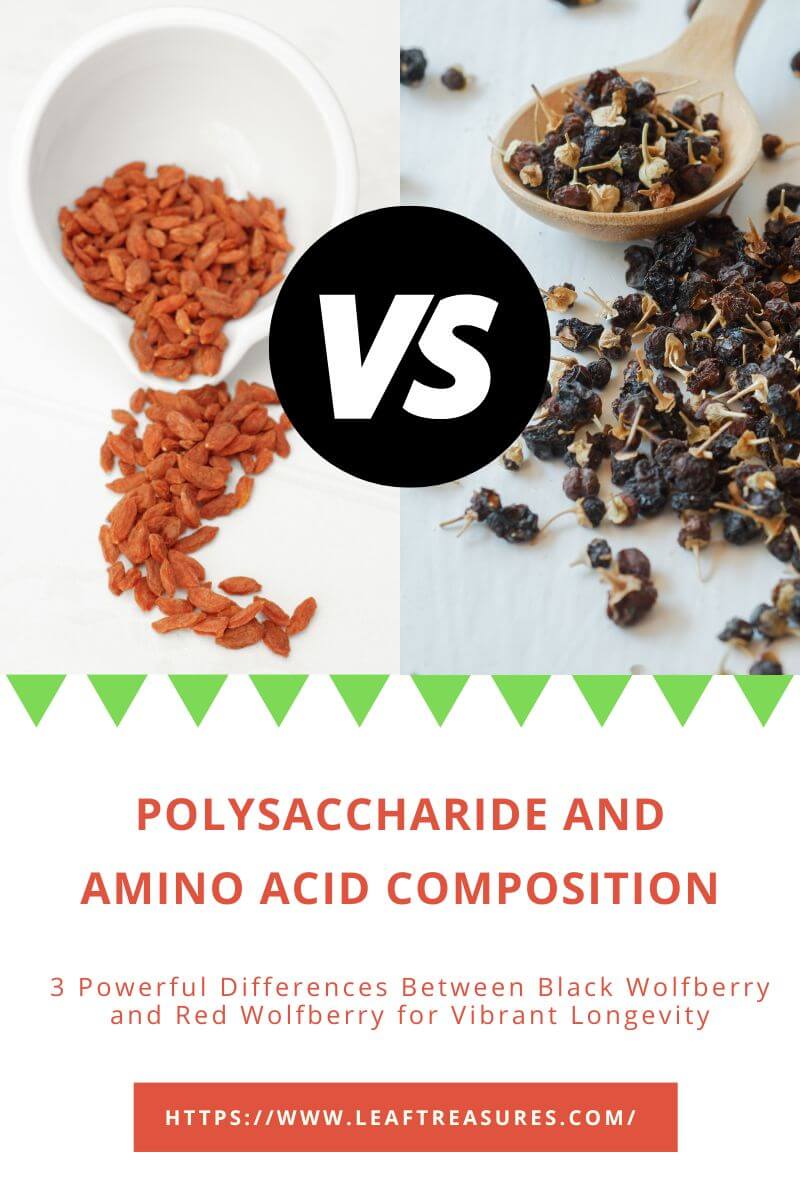
difference between black wolfberry and red wolfberry nutrition:Trace elements and minerals
Black wolfberry has outstanding trace elements. Its selenium content (0.15 mg per 100 g) is 3 times that of red wolfberry, and its iron content (9.2 mg) is 1.5 times that of red wolfberry【5】.
Red wolfberry is rich in calcium (112 mg per 100 g) and magnesium (48 mg), which is more beneficial to bone health.
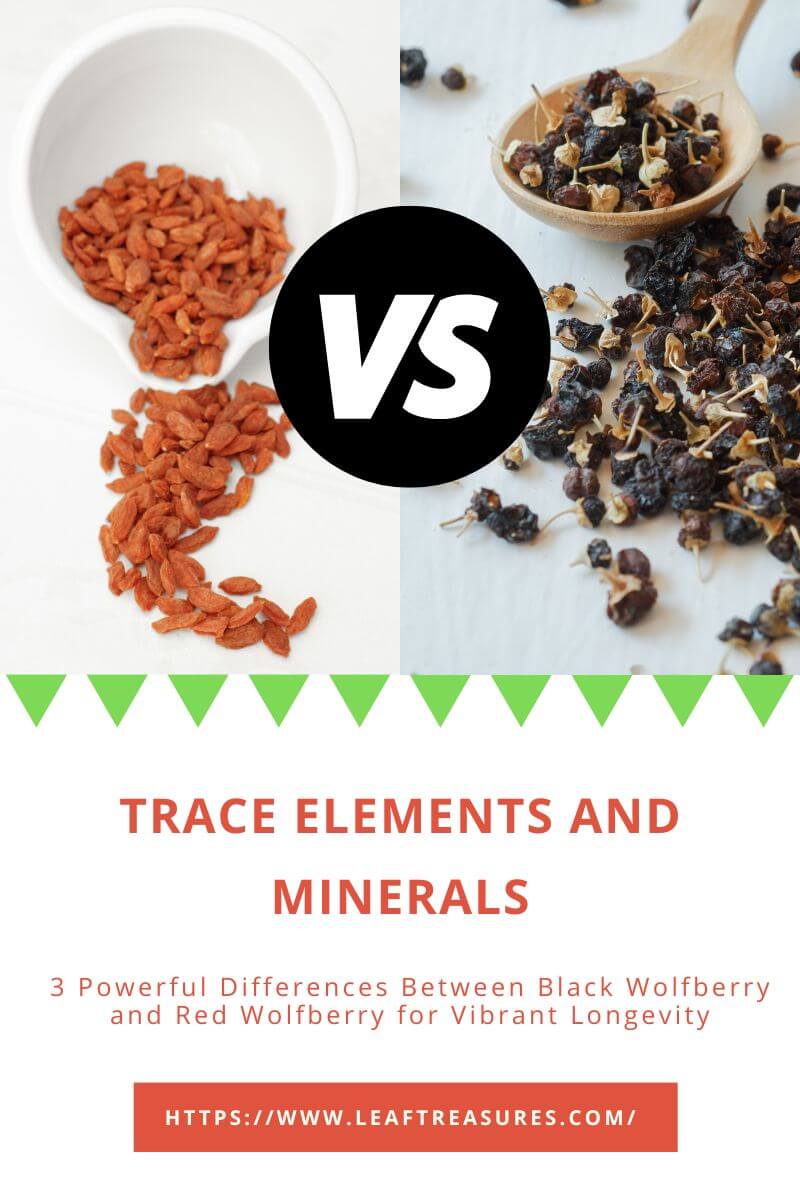
Summary of the difference between black wolfberry and red wolfberry nutrition
In summary, black wolfberry and red wolfberry have their own characteristics in nutritional ingredients and there are significant differences.
Black wolfberry stands out with its extremely high anthocyanin content and becomes a leader in the field of antioxidants. Its rich specific anthocyanin components give it a powerful ability to scavenge free radicals and delay aging.
Although red wolfberry has an extremely low anthocyanin content, it has unique value in antioxidants and vision protection due to its rich vitamin C and carotenoids.
Differences Between Black Wolfberry and Red Wolfberry:
In terms of polysaccharide and amino acid composition, red wolfberry has a higher polysaccharide content and is easier to absorb, and is rich in amino acids that are beneficial to neurotransmitter synthesis;
Black wolfberry, with its high proportion of proline and glycine, is outstanding in promoting collagen synthesis【6】.
In addition, the two also have their own emphasis on trace elements and mineral content. Black wolfberry has a high content of selenium and iron, which helps to enhance immunity and replenish blood;
Red wolfberry is rich in calcium and magnesium, which is essential for maintaining bone health【7】.
Therefore, when choosing to eat, you can reasonably match black wolfberry and red wolfberry according to your personal health needs and nutritional preferences to give full play to their respective advantages and provide the body with comprehensive and balanced nutritional support.
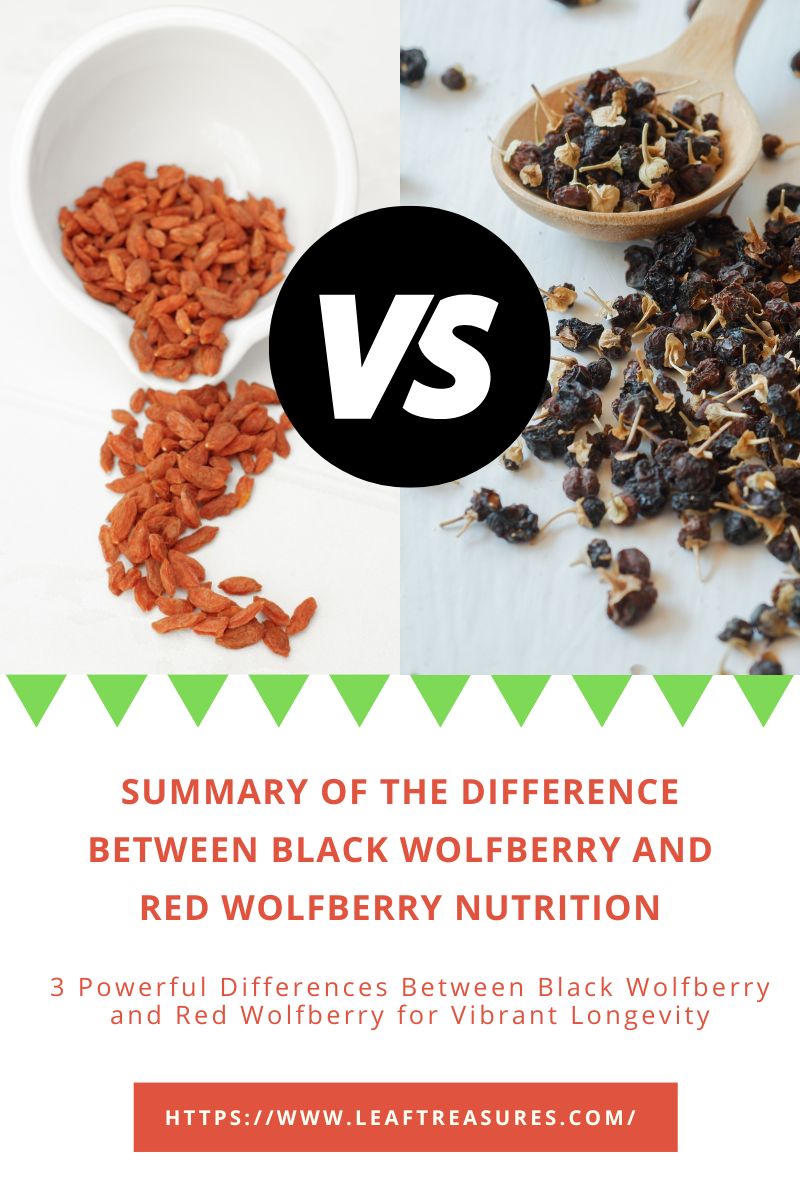
difference between black wolfberry and red wolfberry effects
Because the production environment of black wolfberry and red wolfberry is different, which determines their different nutritional values, the different nutritional values lead to the difference in the efficacy of black wolfberry and red wolfberry.
Many readers are not very clear about the difference between black wolfberry and red wolfberry effects. Next, let us interpret the difference between black wolfberry and red wolfberry effects in detail.
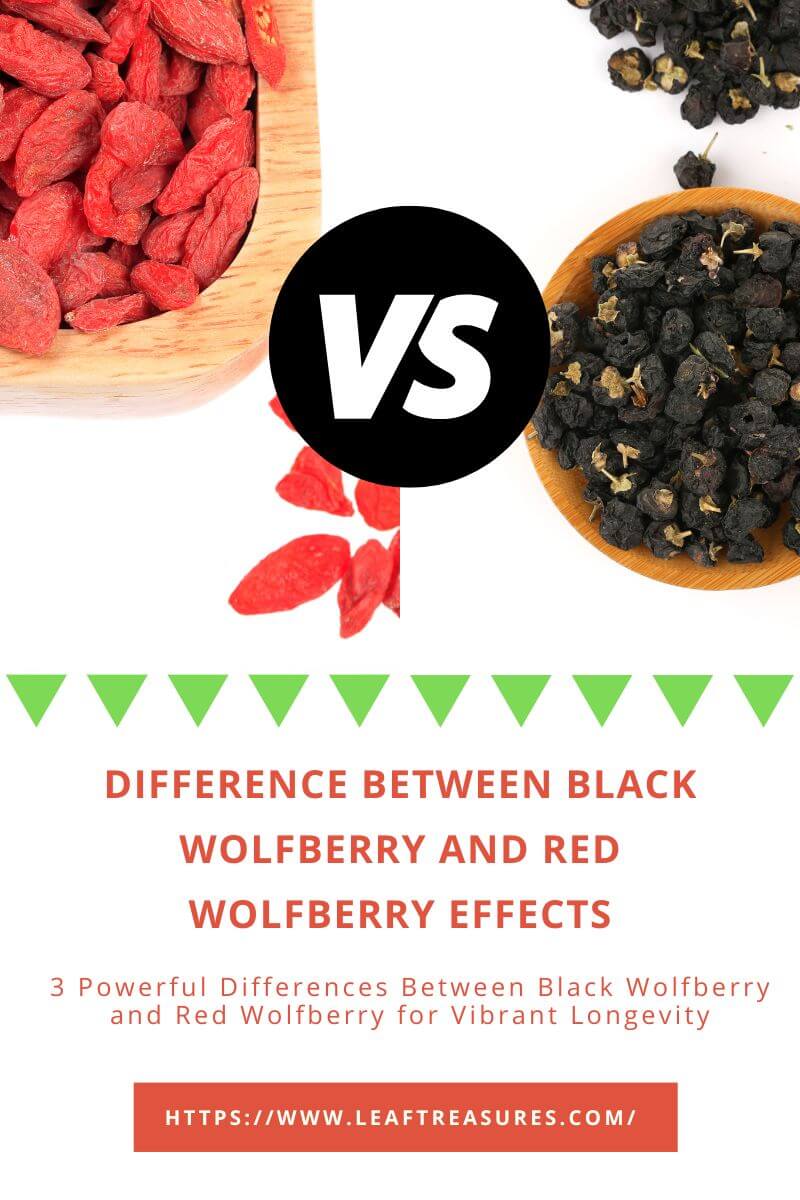
difference between black wolfberry and red wolfberry effects:Antioxidant and anti-aging effects
Anthocyanins in black wolfberry can significantly reduce oxidative stress levels by scavenging free radicals and inhibiting lipid peroxidation.
Animal experiments have shown that mice that have consumed black wolfberry extract (200 mg/kg body weight) for 8 consecutive weeks have a 35% increase in serum superoxide dismutase (SOD) activity and a 28% decrease in malondialdehyde (MDA) content.
Although red wolfberry has a weak antioxidant capacity, its polysaccharide components can activate the Nrf2 pathway and enhance the expression of endogenous antioxidant enzymes in cells.

difference between black wolfberry and red wolfberry effects:Vision protection effects
Anthocyanins can promote the regeneration of retinal rhodopsin and improve dark adaptation ability.
Clinical studies have shown that subjects who consume 120 mg of black wolfberry anthocyanins daily have a 0.3 second shorter reaction time and a 15% higher contrast sensitivity in a night driving simulation test.
Red wolfberry converts β-carotene into vitamin A to maintain the normal structure of the cornea, which has a significant effect on improving the tear secretion of patients with dry eye syndrome.
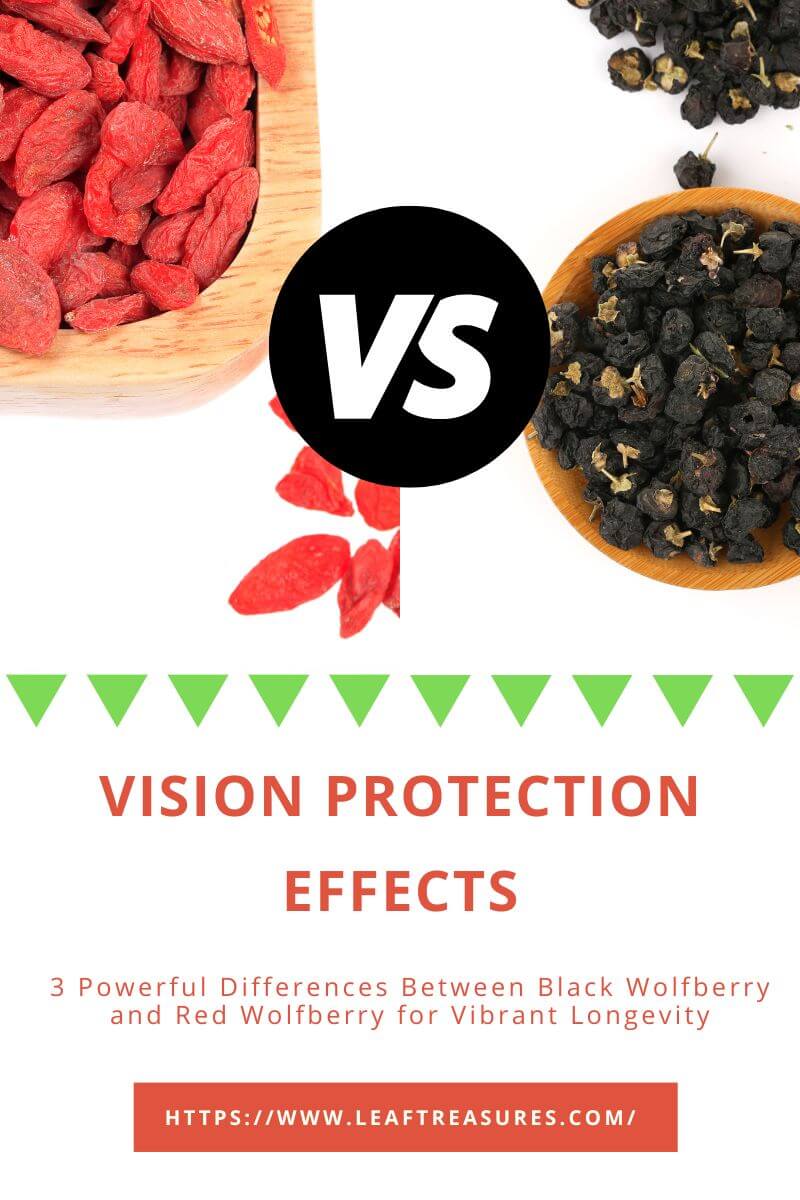
difference between black wolfberry and red wolfberry effects:Metabolism regulation function
Red wolfberry polysaccharide can inhibit the activity of α-glucosidase, delay carbohydrate absorption, and reduce the postprandial blood sugar peak by 22%.
The betaine it contains (1.2 grams per 100 grams) can promote fat metabolism and reduce serum triglyceride levels by 18%.
Black wolfberry activates the AMPK pathway through anthocyanins, enhances insulin sensitivity, and has a better effect on fasting blood sugar control in patients with type 2 diabetes.
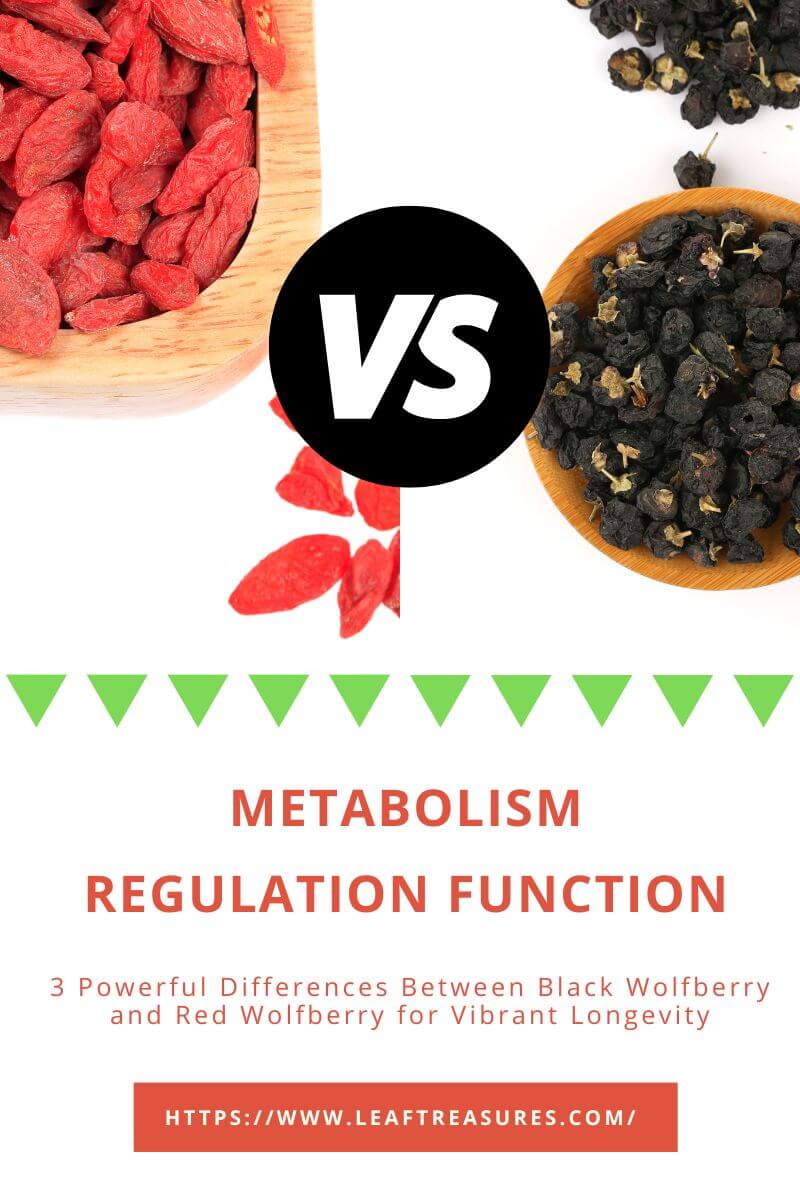
Summary of the difference between black wolfberry and red wolfberry effects
In general, difference between black wolfberry and red wolfberry effects.
Black wolfberry has shown excellent results in the field of anti-oxidation and anti-aging with its high content of anthocyanins.
It effectively delays the aging process of the body by removing free radicals and inhibiting oxidative stress reactions.
At the same time, it has significant effects in enhancing vision and improving dark adaptation ability, especially suitable for people who have long-term excessive eye use or are in a high oxidation environment.
In addition, black wolfberry can also enhance insulin sensitivity by activating specific metabolic pathways, and has a positive auxiliary effect on blood sugar control.
Although the antioxidant capacity of red wolfberry is slightly inferior, its polysaccharide components perform well in activating the endogenous antioxidant mechanism of cells and protecting the integrity of visual structure, especially for eye problems such as dry eyes.
In terms of metabolic regulation, red wolfberry helps maintain blood sugar and blood lipid stability by inhibiting sugar absorption and promoting fat metabolism, and is more suitable for people who need daily metabolic support.
Therefore, the two have different focuses and can be flexibly selected or used in combination according to individual health needs and specific health problems to achieve more precise health management goals.
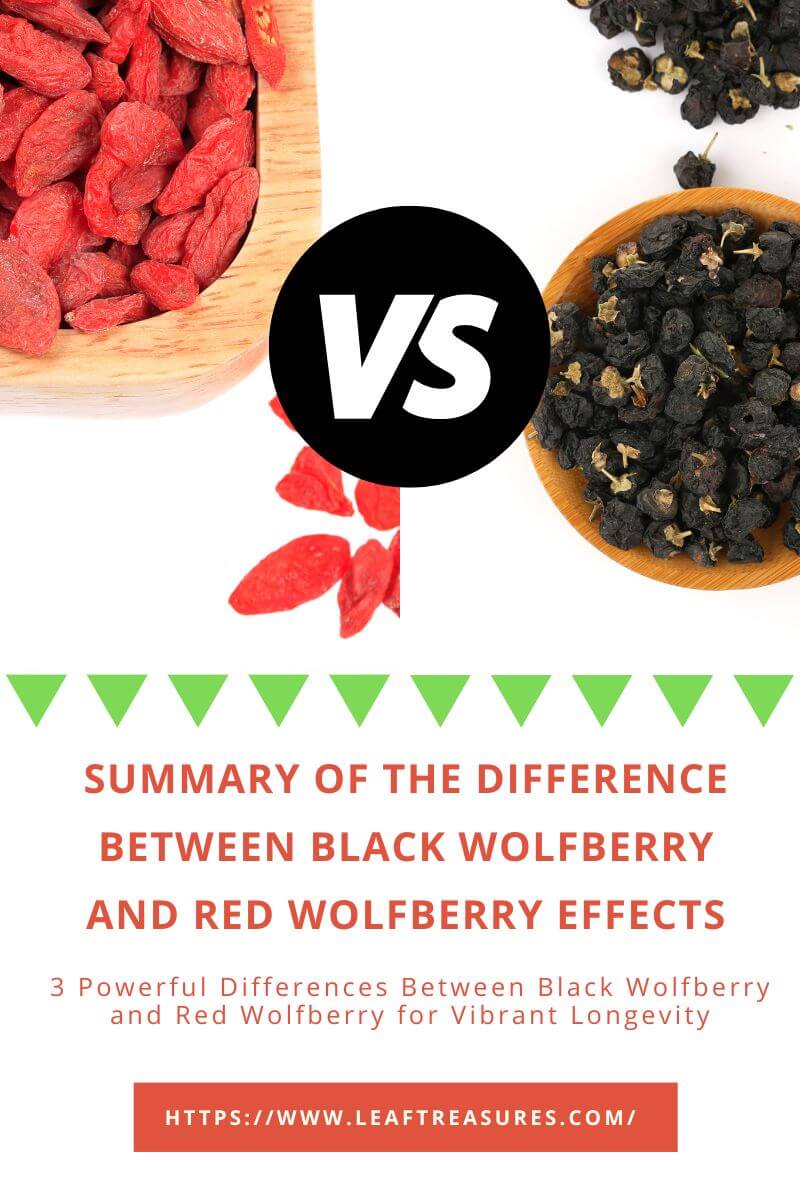
difference between black wolfberry and red wolfberry uses
As we said before, the different production environments of black wolfberry and red wolfberry determine their different nutritional values.
Therefore, the different nutritional values lead to differences in the effects of black wolfberry and red wolfberry.
which directly leads to obvious differences in the uses of black wolfberry and red wolfberry, which are mainly reflected in the core effects, applicable scenarios and actual application methods.
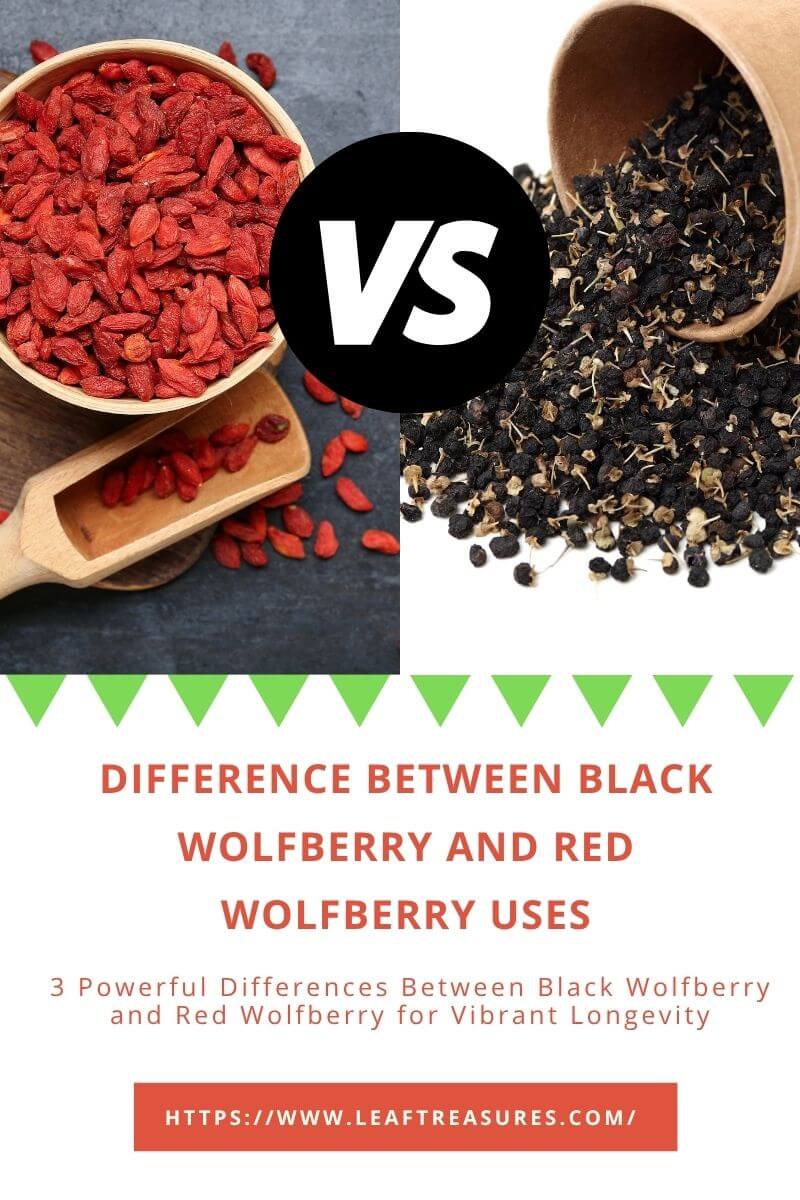
Differences Between Black Wolfberry and Red Wolfberry:Core efficacy differences
The core effects of black wolfberry:
- Antioxidant and anti-aging: Black wolfberry is rich in anthocyanins (the content is more than 10 times that of red wolfberry), and its antioxidant capacity is 20 times that of vitamin C and 50 times that of vitamin E. It can effectively remove free radicals and delay skin and organ aging. It is suitable for people who face electronic screens for a long time, stay up late or need anti-aging.
- Protect eyesight: Anthocyanins can promote the regeneration of rhodopsin in retinal cells, prevent myopia and retinal detachment, and improve night vision. It has a significant effect on programmers, designers and other people who overuse their eyes.
- Improve sleep and blood circulation: Anthocyanins can protect brain nerves, relieve mental stress, improve sleep quality, and promote blood circulation. It is suitable for people with cold hands and feet and shallow sleep.
Core effects of red wolfberry:
- Nourish the body and protect eyesight: Red wolfberry contains polysaccharides, carotenoids (such as β-carotene) and trace elements such as iron, zinc, and calcium. It can regulate immune function and relieve dizziness and vision loss caused by liver and kidney yin deficiency. It is suitable for daily nourishment for middle-aged and elderly people or people with physical weakness.
- Anti-fatigue and energy-enhancing: Red wolfberry polysaccharides can increase liver glycogen reserves, accelerate the removal of metabolic waste after exercise, and relieve fatigue. It is suitable for manual laborers or athletes.
- Lowering blood sugar and blood lipids: Red wolfberry polysaccharides can lower serum cholesterol and triglycerides, assist in controlling blood sugar, and are suitable for daily conditioning for people.
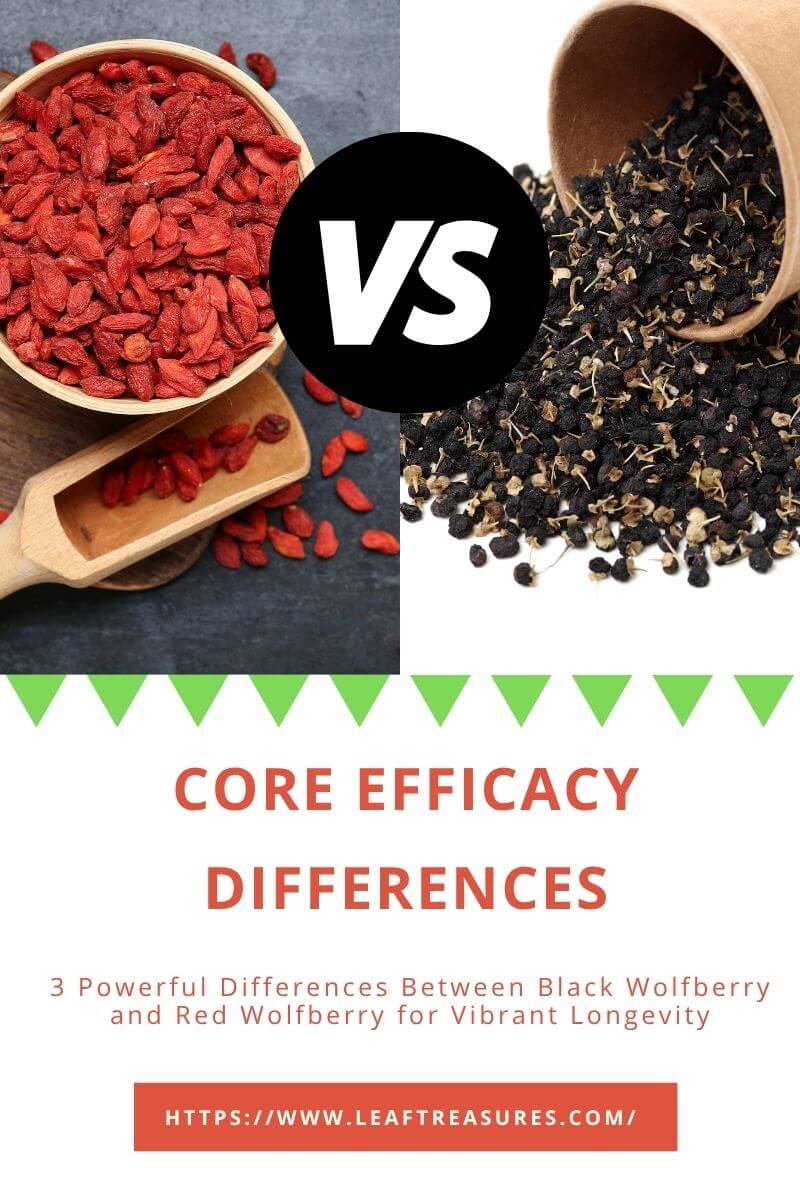
Differences Between Black Wolfberry and Red Wolfberry:Comparison of application scenarios
| Scenario | black wolfberry | red wolfberry |
| Daily Health | For those who use their eyes for a long time, need anti-aging, or have poor sleep quality, it is recommended to soak them in water every day (5-10 capsules) or use them with chrysanthemum and cassia seed for eye protection. | If you are weak and easily fatigued, you can cook porridge (such as wolfberry and red dates porridge) or stew soup (such as wolfberry chicken soup) to strengthen your physical condition. |
| Disease assistance | When diabetic patients need antioxidants, they can eat it in small amounts (because it has a low sugar content); patients with hyperlipidemia can take it with hawthorn and cassia seed to lower blood lipids. | Diabetic patients can consume it in small amounts (no more than 15 grams per day) when they need to control their blood sugar; patients with hypertension should avoid excessive intake (it may increase blood pressure). |
| Beauty and skin care | Black wolfberry anthocyanins can reduce skin pigmentation and are suitable for external application (such as making facial masks) or internal administration (soaking in water) to improve skin tone. | Red wolfberry polysaccharides promote collagen synthesis and can be paired with white fungus and red dates to stew desserts to improve skin elasticity. |
Summary and suggestions
- Choose black wolfberry: if you need strong antioxidant, eye protection, sleep improvement or kidney tonification, and have sufficient budget (black wolfberry is usually 3-5 times the price of red wolfberry).
- Choose red wolfberry: if you need daily nourishment of liver and kidney, anti-fatigue, blood sugar reduction or economical, and have no special contraindications.

Article summary
Although black wolfberry and red wolfberry belong to the genus Lycium of the Solanaceae family, they have significant differences in growth environment, nutritional ingredients, efficacy and use;
Black wolfberry is mainly distributed in high-altitude arid areas, with extremely high anthocyanin content. It is good at anti-oxidation, anti-aging, eye protection and sleep improvement, and is suitable for people who use their eyes for a long time or need anti-aging;
Red wolfberry has a wider adaptability, rich in polysaccharides and carotenoids, and is good at nourishing the liver and kidneys, anti-fatigue, and lowering blood sugar and blood lipids. It is suitable for daily nourishment and metabolic regulation.
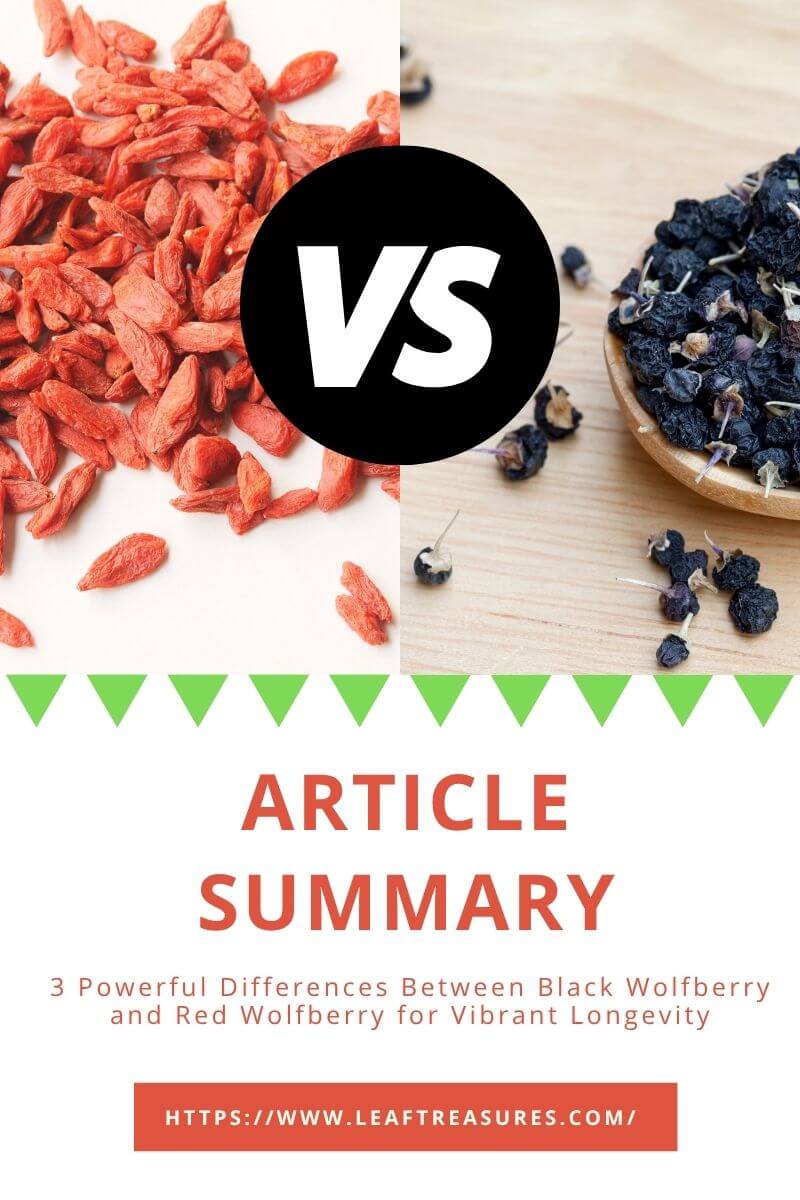
Start a healthy life
After learning more about the Differences Between Black Wolfberry and Red Wolfberry, are you eager to improve your health?
Don’t hesitate, take action now!
Let more people know the health secrets of wolfberries; share your health experience in the comment area, and interact with like-minded friends;
Follow us to get more professional and practical health information;
You can also subscribe to our channel to never miss any opportunity to upgrade your health!
What’s more exciting is that now you can enter our mall and buy more high-quality health products to add color to your healthy life!
Together, move towards a healthier and more vibrant future!
